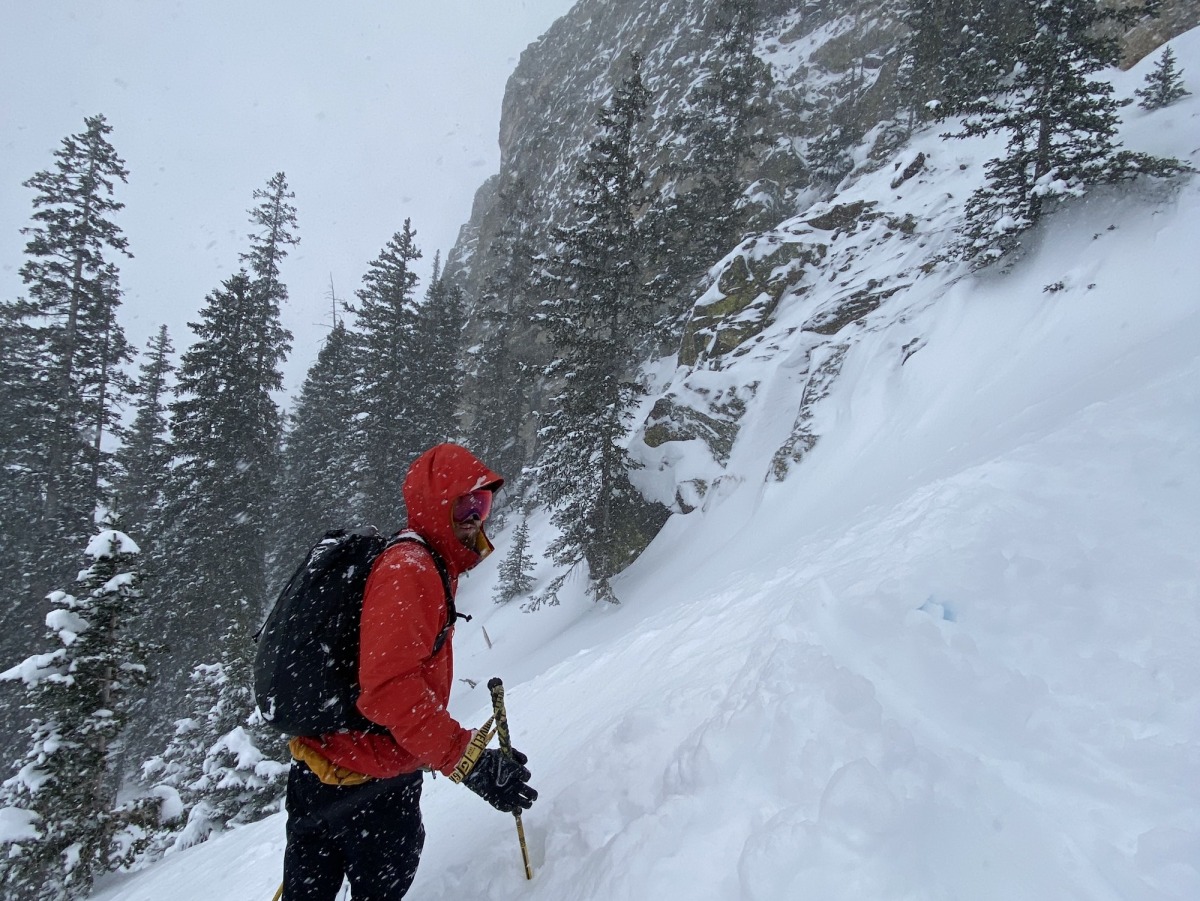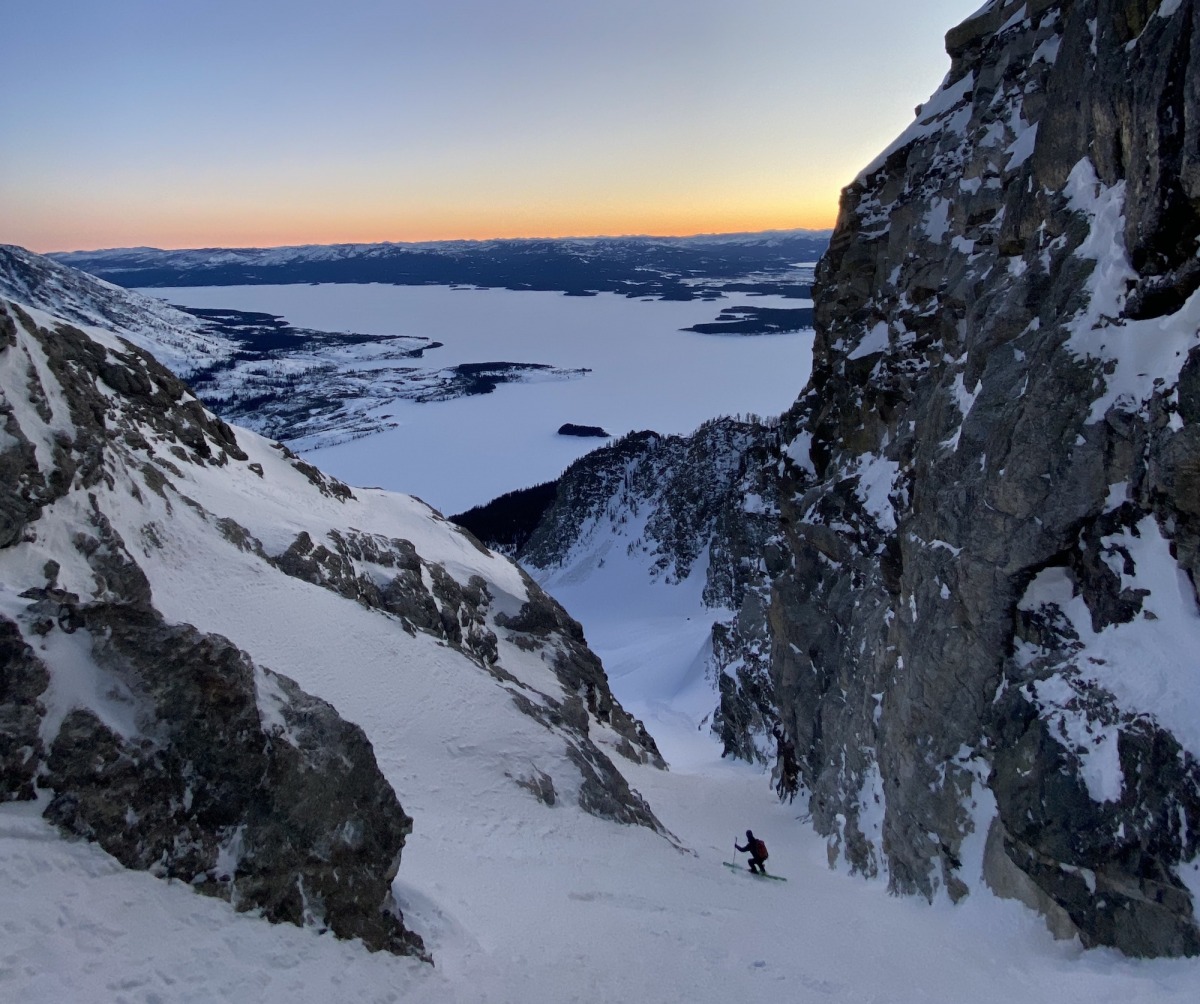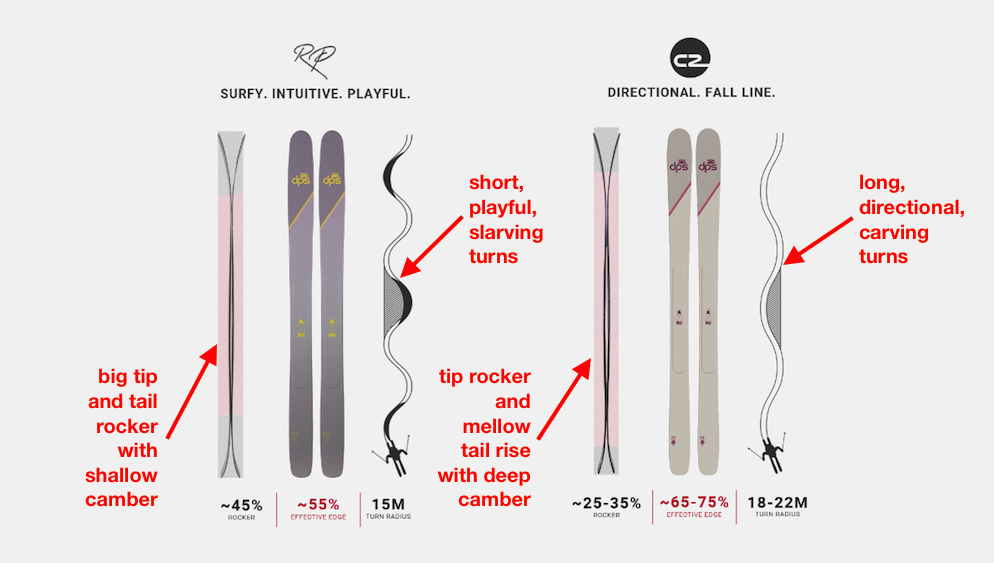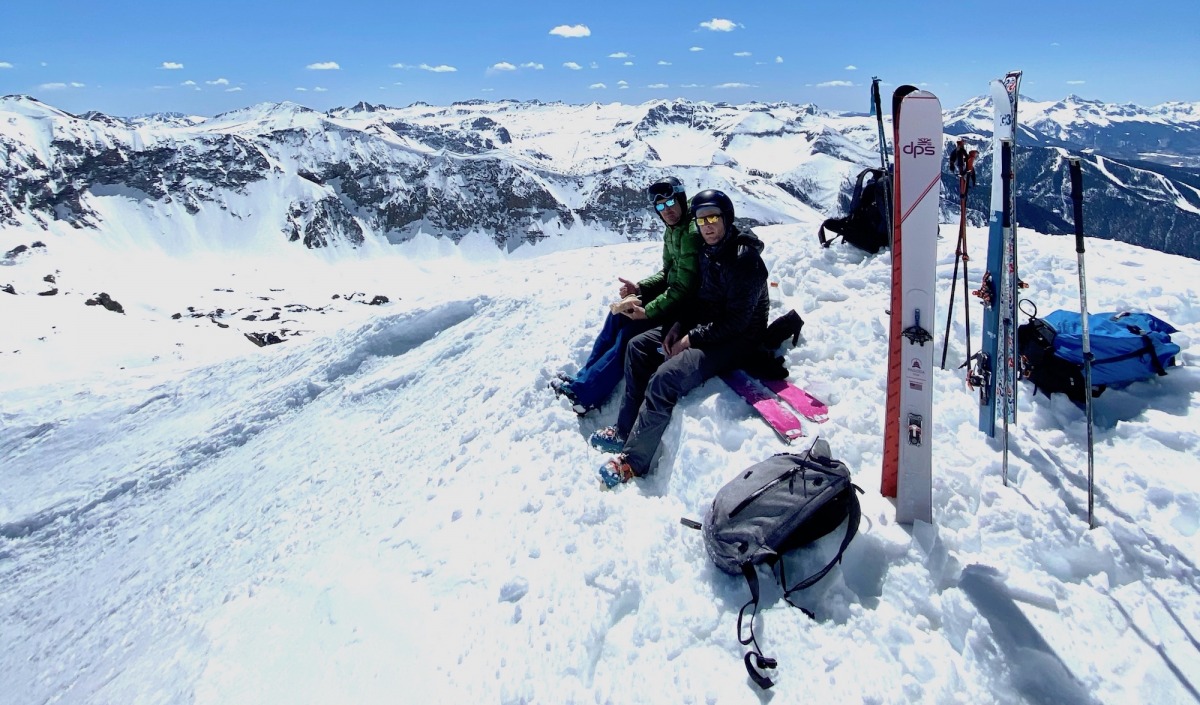
Here we are on top of a Chicago Peak outside of Telluride, CO. We made a bench, snacked on some snacks, and are waiting for corn to soften before putting the 94 C2s to work. They excel in the high speed, big turn arching, corn skiing environment quite well.
We are all familiar with the conceptual backcountry Quiver of One: one ski that can do it all, the jack-of-all-trades-master-of-none. What about adding more specialization by adding a second ski? Is that worth the added complexity and cost of another touring setup? I split the 20/21 winter season in between two skis: the DPS Pagoda Tour 112 RP and 94 C2. I chose the two skis to experiment with the efficacy of a Quiver of Two while also testing a few of the new Pagoda Tour skis from DPS.
The Pagoda Tour series debuted in Fall 2020. I wrote about the construction and shapes for the Pagoda Tour series in detail here. In general, DPS added more advanced manufacturing processes and created unique, unconventional ski designs to make an innovative touring ski.
I tested the DPS Pagoda Tour 112 RP and the DPS Pagoda Tour 94 C2 for the full 20/21 season to get a holistic take on this Quiver of Two pairing. Each ski performs exceptionally well for its intended purpose. The 112 RP is a soft snow powder boat and the 94 C2 is a hard snow mountain tool. When paired together, they more competently cover the course of snow conditions throughout a winter season. Let’s look at each ski individually, then speak to how they complement each other as a Quiver of Two.
DPS Pagoda Tour 112 RP
Product Overview
DPS claims the following about their Pagoda Tour 112 RP: “Transform the skin track into a powder escalator with the award-winning 112 RP shape.” The 112 RP is designed to be the quintessential powder touring ski – a wide, surfy, and playful powder ski shape and profile with a lightweight construction.
I consider there to be two types of wider backcountry skis: powder touring skis (like the 112 RP) and freeride skis. Powder touring skis are big and light. They’re designed for powder wiggles and have a high surface area-to-weight ratio (with a lot of surface area in that equation) to stay on top of deep, fluffy snow. Comparatively, freeride skis are big and heavy. They’re designed for fast, aggressive skiing and have a stable robust construction to help reduce deflection and handle high forces (created from arching turns and jumping off of things). Powder touring skis and freeride skis are both wide skis, but intended for different applications. The DPS Pagoda Tour 112 RP is a great powder touring ski, but not a great freeride ski.
Design Highlights
The 112 RP has a uniquely tapered five-point shape and playfully rockered profile. That design lends itself to a modern, pivoty style of downhill skiing. The short turning radius makes it easy to disengage turns, turning carves into slashes (slarve cough cough). The huge tip rocker and mellow tail rise help these already wide skis float even better in soft snow.
The 112 RP is different from other powder touring skis because it pairs a surfy shape/profile combo with a lightweight yet damp construction. The Pagoda Tour line has a pour-in sidewall that is continuous around the perimeter of the ski. It also has two layers of the vertically laminated core material. This (plus two layers of carbon fiber) is a lot of construction to fit into the ski’s modest 1550-gram mass. Other similar powder touring skis don’t handle non-powder snow nearly as well as the 112 RP, and I presume it’s due to the advanced and fancy construction.
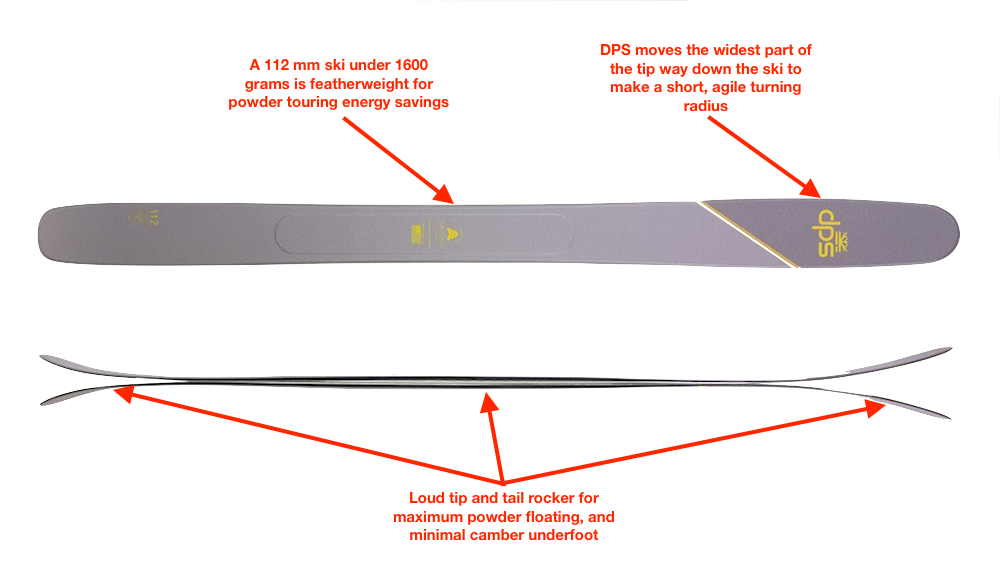
Shape and profile highlights for the DPS Pagoda Tour 112 RP. Mute graphics make it/you look under the radar and cool, right?
Well, if the 112 RP is great at powder touring, what is it bad at? The 112 RP doesn’t ‘charge’ or ‘huck cliffs’ or ‘rail turns’ as a freeride ski would (for an example of comparison, a great backcountry freeride ski is the Faction Agent 4.0). The 112 RP has a lower-than-freeride speed limit, and that’s a good thing. It’s intended to, and ideal for, low-to-medium speed powder skiing where rooster tails of pow pow are to be thrown in the air with each turn. Maybe the angle of the slope is below 30°. Maybe you’re not in a gnarly ski film on an Alaskan spine. Those are just fine circumstances for most of us backcountry skiers. What the 112 RP has that its freeride brethren doesn’t is enough pep in its step for multiple laps in the backcountry. Freeride skis are just too heavy for big days in the mountains.
Field Test
I tested the 112 RP throughout the season from mid-November to early March. They were my soft snow daily drivers and shook me with how fun they made powder skiing (which is already fun!). A particularly outrageous powder outing was with my friend Gavin in local below-treeline terrain. We left the trailhead with it snowing well over 2 cm/hour and plenty of fresh snow already on the ground. Our day was spent voraciously skiing as much powder as we could while attempting to stay dry in the stormy weather, stay fueled to make sure we could stay out as long as possible, and keep all of the fresh snow out of our open-mouthed, laughing, smiling faces. It was the best day of powder skiing of my life (so far). The 112 RP was a huge player in this story because my legs felt fresh all day. We could race uphill, transition with fury, frolic through waist deep bliss, eat a snack, and repeat the process. This day was the affirming example of why powder touring skis rock. My legs would have been dead if I was on a heavier ski, but I needed every millimeter of underfoot width provided by the 112 RP for the depth of the downhill skiing.
I recommend to size this ski big because of the generous tip and tail rocker. Less of the ski is in contact with the snow, so it will ski shorter than perceived at first sight. Through the season, the 112 RP reminded me of two different skis: the now discontinued La Sportiva Vapor Float (117 mm underfoot) and the Voile Hyper V8 (115 mm underfoot). These are other prominent powder touring skis with similar shapes/profiles to the DPS powder boat. However, the Pagoda Tour has a much more robust construction compared to these models. This will make the 112 RP more competent in not-powder snow and make the ski more durable. For such a lightweight touring ski, these things can handle use/abuse. I have skied them 60+ days this season with negligible base/topsheet damage and the profile has fully maintained its contour. I’m impressed with their durability enough to make a note of it here and commend DPS for building a more robust ski at the expense of a few grams (but still keeping it at a relatively light weight).
Additional Thoughts
The DPS Pagoda Tour 112 RP delivers when they say it will ‘transform the skin track into a powder escalator.’ It is one of the best powder touring skis that I’ve been exposed to. It’s lightweight and provides a shape and profile to complement playful powder skiing. The 112 RP is for the human-powered powder skier that has a more playful than aggressive skiing style and wants something that is light and lively.
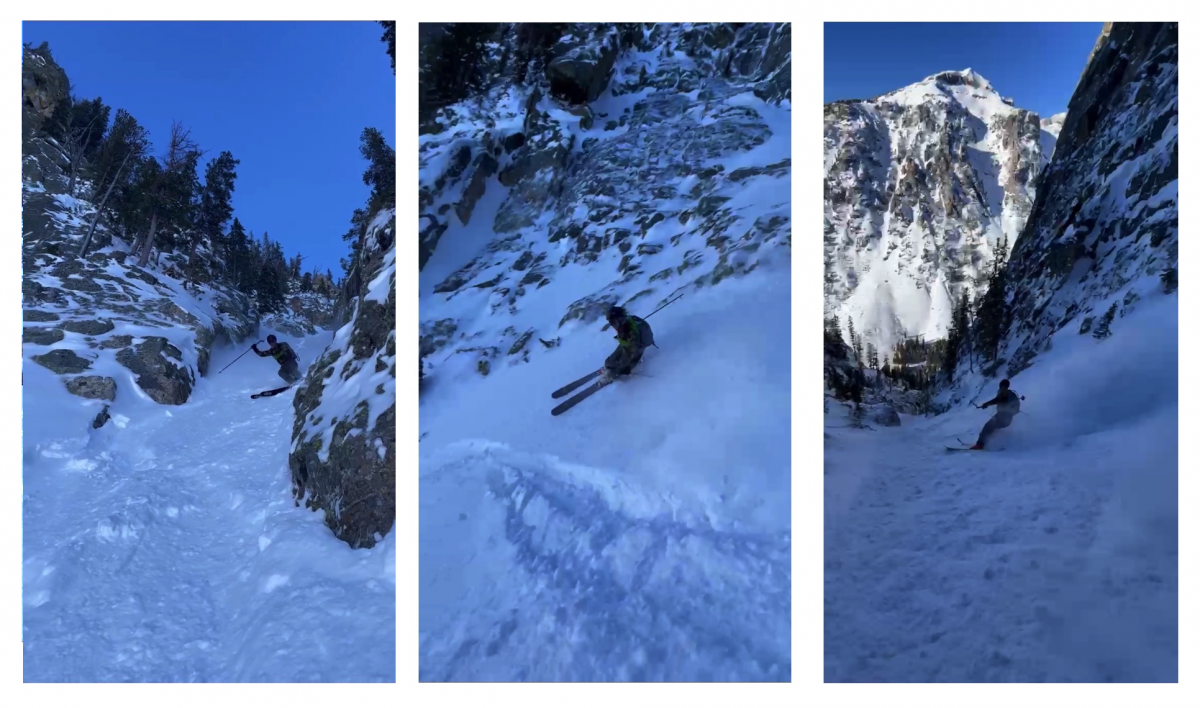
Here are the 112 RP’s at work: slashing and carving in boot top powder. I was impressed with the dexterity and tight turning of these skis while in this narrow couloir.
Metrics
Available lengths (cm): 158, 168, 178, 184 (size tested)
Dimensions (mm): Claimed: 140-112-127; Measured: 140-113-125
Claimed Sidecut (m): 15
Mass (g): Claimed: 1580; Measured: 1592
Mount Position (mm): (1840/2)-777= + 143 (very rear-mounted)
(equation = ½ total length of ski – measurement to boot center from the tail. + means its rear-mounted, 0 means its center-mounted, – means its front-mounted)
Construction (bottom to top): UHMW polyethylene base, prepreg carbon fiber, the vertically laminated core of ash, paulownia and aerospace grade foam, another layer of vertically laminated ash, another layer of pre-impregnated carbon fiber weave, HDPE mounting plate, textured polyamide topsheet
Shape: Spoon-shaped tapered tip, short turning radius, tapered tail
Profile: Big and long tip rise, shallow camber, medium tail rise
Recommended Binding & Boot Pairing: The Salomon MTN is a simple yet robust binding option for this powder-touring ski. The Atomic Backland Pro, Dynafit TLT8 Expedition, or Scarpa F1 LT (depending on the shape of your foot) are all appropriate compliments to the 112 RP with an MTN binding. This ski/binding/boot pairing would create a powder touring rig that weighs under 3500 grams per foot (but who’s counting right?).
MSRP: $1,299 (!)
DPS Pagoda Tour 94 C2
Product Overview
DPS portrays the Pagoda Tour 94 C2 as such: “The 94 C2’s footprint allows for a variety of turn shapes; from sidecut-perfect carves to short radius windshield wiper turns, you’ll feel at home aboard this versatile backcountry specific ski.” This member of the Pagoda Tour family is a mountain tool: a utilitarian instrument for mountain travel on snow. I intended to use the Pagoda Tour 94 C2 as a hard snow ski in contrast to the soft snow 112 RP. I wanted the 94 C2 to be a stable and reliable ski for:
— Frozen, variable, challenging conditions
— Timing corn skiing
— Technical skiing where edge control and security are paramount
— Ski traverses where weight savings is important
Fortunately enough, the 94 C2 has performed confidently under all of the listed conditions.
Design Highlights
The amount of tip and tail rise in this 94 mm ski is atypical, and that makes the Pagoda Tour 94 C2 unique for its size. The added rocker provides better floatation in deeper snow and easier turn engagement when on hard snow.
This ski performed with predictability and reliability. Those nouns aren’t sexy or flashy ways to describe a ski and that’s exactly what I was looking for out of a ‘mountain tool’ type of ski. The 94 C2 promotes safe, confident, easy skiing, ideal for technical terrain, variable snow, and long days out [when legs eventually get tired]. It handled fine in deeper snow conditions with the tip and tail rocker (it has more rocker than usual for a 94mm waisted ski). But, if there’s a chance of deep snow for a tour, I typically to opt for a wider ski.
Field Test
A memorable day on these skis was spent touring up a local classic with my two great friends Sheamus and Morgan. The morning started with a refrozen, ice rink-quality skin track. We eventually broke through tree line into an alpine basin that had a microwave radiation quality of heat and accompanying sticky snow. We then bootpacked up the approach couloir and scrambled over a rocky ridge to reach the entrance of our desired descent. The way down started as powder, led to an icy choke, was preceded by variable powder runnels and firm bed surface, then eventually finished in a few thousand feet of planar, surfy, FUN corn skiing to the valley floor.
Did you notice anything about our day out? I didn’t mention the ski’s performance once and that’s the ideal scenario for a ski during a big mission. I don’t want to be bogged down with the ski’s weight while on the skin track or in the bootpack. When skiing down, I want to focus on snowpack conditions. I want a ski that works in the background at making big tours feel easy – both up and down. That’s exactly what the DPS Pagoda Tour 94 C2 has done throughout this season. It’s an undercover mountain tool that performs in a variety of terrain with predictability. It’s something I can trust to carry me up and glide me down.
With that field testing anecdote in mind, I have a few more points to address. The Pagoda Tour construction makes this ski lightweight, but not ultralight. The added weight makes it more stable when things get chunky and allows for less deflection and better skiability compared to UL (ultralight) 90-100 mm equivalents (like the Movement Alp Tracks 95 or the Fischer Hannibal 96). The Pagoda Tour is 100-200 grams heavier than the mentioned UL touring options, and I appreciate the added weight in exchange for the added downhill confidence. The most similar ski to the Pagoda Tour 94 C2 is the Salomon MTN 95. They are both light, but not too light. But side-by-side, the 94 C2 features more durable construction, more tip, and tail rise, and a stiffer flex pattern. This gives the DPS ski a high upper-speed limit and more soft snow competence at the same weight as the MTN 95. There are obviously other 90-100 mm options that I’m curious to engage in discussion about in the comments below. If interested in the 94 C2, I would size it from nose height to top-of-head height. Size close to your nose height for weight savings and better dexterity in tight terrain. Size to close to the top of your head for more stability at high speeds and more float in deeper snow.
Additional Thoughts
The DPS Pagoda Tour 94 C2 is not a flashy ski. It’s reliable, versatile, and dependable. It’s a quality skinny all-season touring ski recommended for the all-season backcountry traveler who prioritizes edge-ability over float-ability. It’s great in hard snow conditions, and gets by better than most other 90-100mm waist-width skis in powder conditions because of the atypical amount of tip and tail rocker.
Metrics
Available Lengths (cm): 157, 165, 171 (size tested), 178, 185
Dimensions (mm): Claimed: 129-94-109; Measured: 129-94-111
Claimed Sidecut (m): 18.5
Mass (g): Claimed: 1360; Measured: 1350
Mount Position (mm): (1710/2)-755= +100 (rear-mounted)
(equation = ½ total length of ski – measurement to boot center from the tail. + means its rear-mounted, 0 means its center-mounted, – means its front-mounted)
Construction: same as the Pagoda Tour 112 RP
Shape: Bulbous rounded tip, medium sidecut, tapered tail
Profile: Shallow tip rise, medium camber, shallow tail rise
Recommended Binding & Boot Pairing: A race binding with an adjustment plate is a great pairing for this ski. The Ski Trab Gara Titan, the BD Helio 145, or the Plum Race 170 would all be ideal binding matches. To match that lightweight binding, get a race/touring boot like the Scarpa F1 LT or Atomic Backland Carbon.
MSRP: $1,299
Shop for DPS Pagoda Tour 94 & 112 skis.
Slator Aplin lives in the San Juans. He enjoys time spent in the mountains, pastries paired with coffee, and adventures-gone-wrong. You can often find him outside Telluride’s local bakery — Baked in Telluride.

